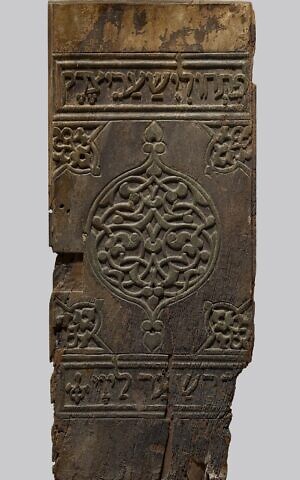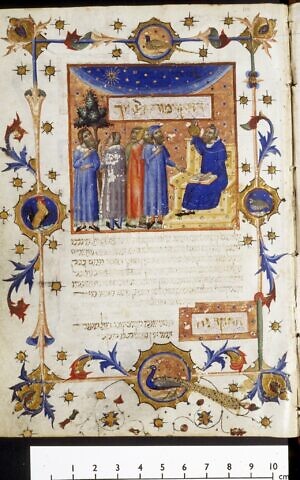NEW YORK — In 1784, three years after the American Revolution, New York City cantor Hendla Jochanan van Oettingen composed a prayer for the well-being of Gen. George Washington and Gov. DeWitt Clinton. That prayer may have been lost to history — had it not been for the way van Oettingen knitted Maimonides’ 13 Principles of Faith together with the newfound freedom of the original 13 states.
Now that parchment is on display in “The Golden Path: Maimonides Across Eight Centuries,” a new Yeshiva University Museum exhibition at the Center for Jewish History. Like the many manuscripts and artifacts on exhibit — some for the first time — the prayer illustrates the far-reaching impact and influence of one of the Middle Age’s most prolific Torah scholars.
Born in 1138 in Córdoba, present-day Spain, Moses ben Maimon, or Maimonides, was a Sephardic rabbi, doctor and philosopher. After the forced exile of Córdoba’s Jews in 1148, he worked and lived in Morocco and Egypt, where he served as the personal physician of the sultan Saladin. In Jewish scholarship as well as philosophy and science, Maimonides was ahead of his time — and as an effect, despite being revered by many, his philosophical work was considered heretical by some rabbis and banned, even into the 19th century.
“It’s fascinating to see the multiplicity of Maimonides. He was so prolific and expansive; everyone can see themselves in his work,” said Dr. David Sclar, the exhibit’s guest curator.
As one walks through the show’s three sections, “Luminary,” “Radiance,” and “Prism,” it becomes clear that Maimonides is both a mirror and a lens for generations after his death in Egypt in 1204.
“He was a proper polymath. People can elevate the aspect of him they most relate to; there is the power of his ideas, the power of his identity, and the power of his written words. One can take a piece of him and make it prime,” said Gabriel Goldstein, associate director for exhibitions and programs at Yeshiva University Museum.
The Book of Commandments, or Sefer Hamitzvot, by Moses Maimonides; Yemen, 1492. (Hartman Family Collection/ From the Yeshiva University Museum exhibition ‘The Golden Path: Maimonides Across Eight Centuries’)
Science buffs and academics might be interested in how Sir Isaac Newtown consulted Maimonides’ Laws of the New Moon when he reformed the Julian Calendar. For artists, there is Ben Shahn’s 1957 portrait of Maimonides’ “Science and the Humanities,” which served as the model for the mosaic mural now gracing the William E. Grady Career and Technical Education High in Brooklyn.
Others might be interested in Maimonides’ hand-drawn menorah whose angular, rather than curved, design has been adopted today by the Chabad movement for public Hanukkah celebrations. And for anyone into pop culture, there is an iPhone case and a pink onesie, both of which bear the sage’s likeness.

Panel from a Torah ark door, Egypt, 11th century, with later carving and paint. (The Walters Art Museum, Baltimore [funds provided by the W. Alton Jones Foundation Acquisition Fund, 2000] and Yeshiva University Museum [funds provided by the Jesselson Foundation]/ From the Yeshiva University Museum exhibition ‘The Golden Path: Maimonides Across Eight Centuries.’ Photo by Susan Tobin)
Through a partnership with international collections, the show, which runs through December, boasts the most impressive collection of Maimonides manuscripts and artifacts ever to be displayed together, Sclar said.
Among the pieces on loan are 13th-century Yemenite manuscripts and early printed books from the Italian State Archives. There are texts produced by and for Christian audiences from the Chicago-based Hartman Collection, the most significant private collection of Maimonides manuscripts and rare books. The Bodleian Libraries in Oxford loaned two illuminated manuscripts, both of which bear his signature. Additionally, there are fragments from the Cairo Genizah on loan from the Library of the Jewish Theological Seminary.
Aside from the manuscripts, there is a carved 11th-century door to the Torah ark from Cairo’s Ben Ezra Synagogue. Although Maimonides was not a member of the synagogue, he would have seen it while living there, Goldstein said.

Guide of the Perplexed, Barcelona, 1347 or 1348, by Moses Maimonides. (The Royal Danish Library, Copenhagen/ From the Yeshiva University Museum exhibition ‘The Golden Path: Maimonides Across Eight Centuries’)
Also on display is the first major public viewing of a “Moreh Nevukhim,” or “Guide to the Perplexed” — Maimonides’ principal philosophical work. Completed in 1349, the lavishly illuminated manuscript is on loan from The Royal Library in Copenhagen.
Even now, the gold leaf decorating the margins has not lost its sheen and the blue peacock still pops from the page. Considered one of the finest examples of the illumination traditions of that era, the nearly pristine condition of the manuscript shows the reverence people had, and continue to have, for Maimonides’ ideas.
“It’s absolutely breathtaking,” Goldstein said, adding that he feels a personal connection to the work since he first saw it decades ago while working as a summer intern.
Sclar, who is also a high school teacher at The Frisch School in New Jersey, said it was important to him that the exhibit be accessible to middle school students, serious academics, and everyone in between.
“Seeing these pieces in his hand are significant because it lets us see Maimonides was a person. My deepest desire is that people will look at these things and sit down, talk, and learn from each other,” Sclar said.
